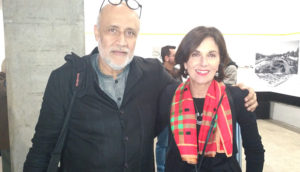Flexibility is the foundation for kinetic cities
Rahul Mehrotra with Dean of the Faculty of Built Environment at UNSW, Helen Lochhead
By Vijay Badhwar
Renowned Indian architect, urban designer and professor, Rahul Mehrotra, is in town and delivered an interesting talk last night, May 2, 2017, as part of Utzon Lectures at the University of NSW. The talk was not about permanent urban design solutions which he called static, but about the dominant Indian theme of transient nature of life, ephemeral, ever changing and involving shared spaces that rather enriched life and made it interesting. He called them kinetic cities.
Rahul embellished his talk with powerful images, rich in colour and traditions, of Ganesha Visarjana in Mumbai and Kumbh Mela on the banks of Ganges river in Allahabad. The life suddenly changed to cater for millions of new arrivals, temporary structures were put up and services provided, that disappeared overnight as the festivities culminated, he said.
The audience included professional architects and academics among students, former NSW Government Architect Peter Mould and Dean of the Faculty of Built Environment at UNSW, Helen Lochhead. They were all enthralled with the flexibility that allowed such major transitions, leaving no footprint behind either on the landscape or the environment as the materials were recycled in totality. A case in point was using a cricket field as a function centre in the evening, the bamboo structures recreating grand entrances and palaces that disappeared after the event, leaving the pitches intact for games to proceed as scheduled.
The ”˜kinetic cities’ idea is an important concept that may be relevant to solve contemporary problems like accommodating millions of refugees or in emergency situations arising from natural disasters.
Rahul Mehrotra was dismissive of the idea of ”˜Smart Cities’ propounded by Modi Government that simply superimposed images of modern cities from Google Maps, indifferent to the local environment and unmindful of the required infrastructure and even the need to provide living spaces for its inhabitants.
After the talk, he discussed with The Indian Down Under that vertical cities were not an answer to enormous demand on the limited land available to the large Indian population. Rahul said that unreliability of lifts in high rise buildings, short supply of energy and provision of extensive infrastructure and services were factors against vertical development in the Indian context.
Short URL: https://indiandownunder.com.au/?p=8812

